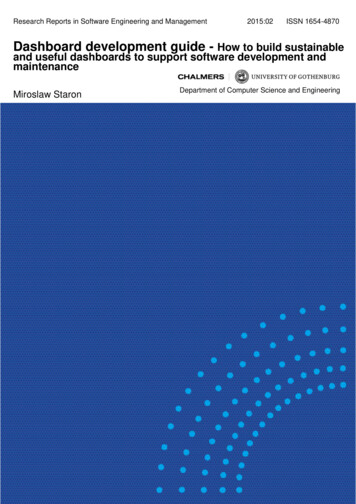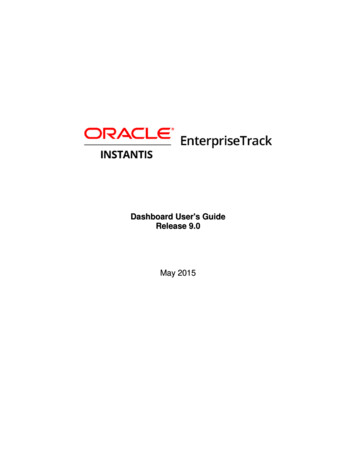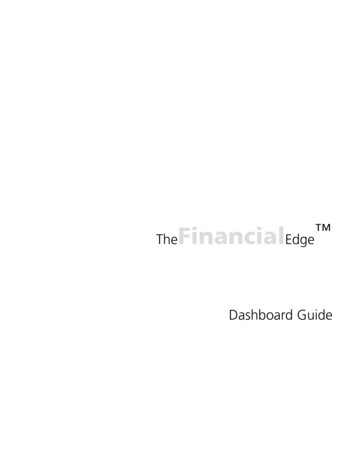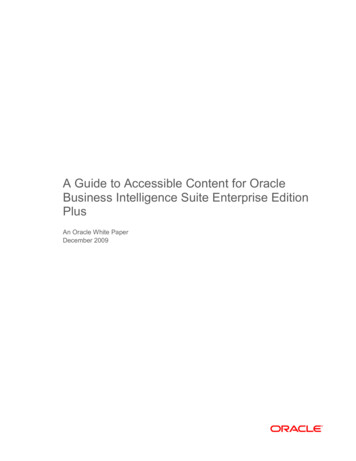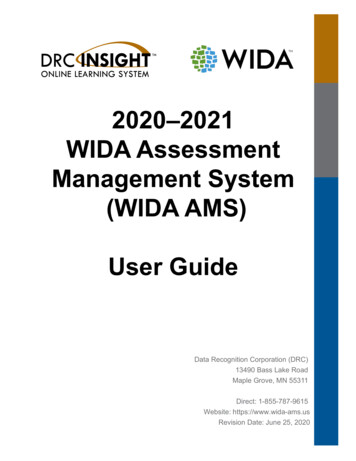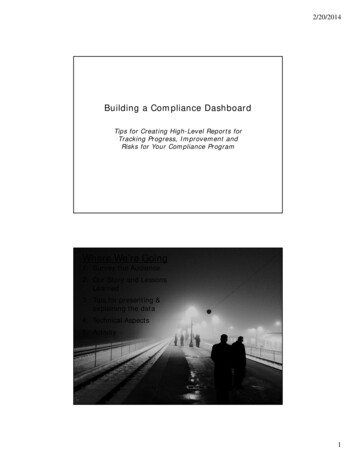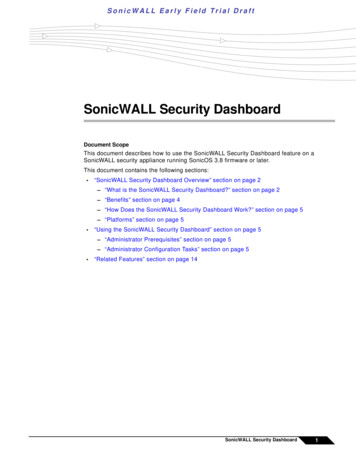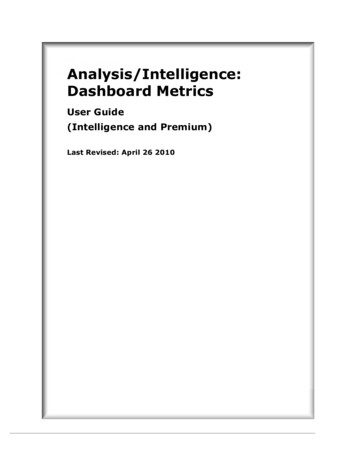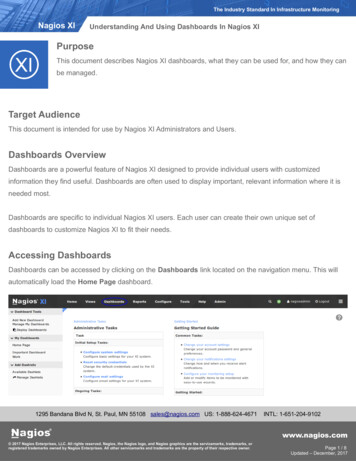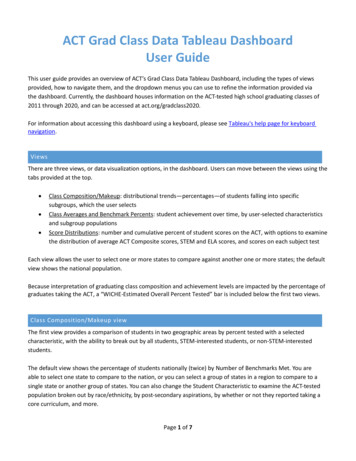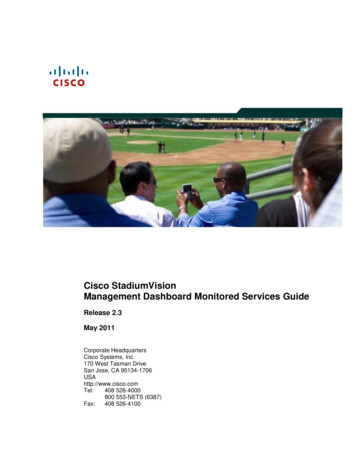
Transcription
Cisco StadiumVisionManagement Dashboard Monitored Services GuideRelease 2.3May 2011Corporate HeadquartersCisco Systems, Inc.170 West Tasman DriveSan Jose, CA 95134-1706USAhttp://www.cisco.comTel:408 526-4000800 553-NETS (6387)Fax:408 526-4100
THE SPECIFICATIONS AND INFORMATION REGARDING THE PRODUCTS INTHIS MANUAL ARE SUBJECT TO CHANGE WITHOUT NOTICE. ALLSTATEMENTS, INFORMATION, AND RECOMMENDATIONS IN THIS MANUALARE BELIEVED TO BE ACCURATE BUT ARE PRESENTED WITHOUTWARRANTY OF ANY KIND, EXPRESS OR IMPLIED. USERS MUST TAKE FULLRESPONSIBILITY FOR THEIR APPLICATION OF ANY PRODUCTS.THE SOFTWARE LICENSE AND LIMITED WARRANTY FOR THEACCOMPANYING PRODUCT ARE SET FORTH IN THE INFORMATION PACKETTHAT SHIPPED WITH THE PRODUCT AND ARE INCORPORATED HEREIN BYTHIS REFERENCE. IF YOU ARE UNABLE TO LOCATE THE SOFTWARELICENSE OR LIMITED WARRANTY, CONTACT YOUR CISCOREPRESENTATIVE FOR A COPY.The Cisco implementation of TCP header compression is an adaptation of aprogram developed by the University of California, Berkeley (UCB) as part of UCB‟spublic domain version of the UNIX operating system. All rights reserved. Copyright 1981, Regents of the University of California.NOTWITHSTANDING ANY OTHER WARRANTY HEREIN, ALL DOCUMENTFILES AND SOFTWARE OF THESE SUPPLIERS ARE PROVIDED “AS IS” WITHALL FAULTS. CISCO AND THE ABOVE-NAMED SUPPLIERS DISCLAIM ALLWARRANTIES, EXPRESSED OR IMPLIED, INCLUDING, WITHOUT LIMITATION,THOSE OF MERCHANTABILITY, FITNESS FOR A PARTICULAR PURPOSE ANDNONINFRINGEMENT OR ARISING FROM A COURSE OF DEALING, USAGE, ORTRADE PRACTICE.IN NO EVENT SHALL CISCO OR ITS SUPPLIERS BE LIABLE FOR ANYINDIRECT, SPECIAL, CONSEQUENTIAL, OR INCIDENTAL DAMAGES,INCLUDING, WITHOUT LIMITATION, LOST PROFITS OR LOSS OR DAMAGE TODATA ARISING OUT OF THE USE OR INABILITY TO USE THIS MANUAL, EVENIF CISCO OR ITS SUPPLIERS HAVE BEEN ADVISED OF THE POSSIBILITY OFSUCH DAMAGES.Cisco and the Cisco Logo are trademarks of Cisco Systems, Inc. and/or its affiliatesin the U.S. and other countries. A listing of Cisco's trademarks can be found atwww.cisco.com/go/trademarks. Third party trademarks mentioned are the propertyof their respective owners. The use of the word partner does not imply a partnershiprelationship between Cisco and any other company. (1005R)Any Internet Protocol (IP) addresses and phone numbers used in this document arenot intended to be actual addresses and phone numbers. Any examples, commanddisplay output, network topology diagrams, and other figures included in thedocument are shown for illustrative purposes only. Any use of actual IP addressesor phone numbers in illustrative content is unintentional and coincidental.Copyright 2011 Cisco Systems, Inc. All rights reserved. 2011 Cisco Systems, Inc. All rights reserved.Page 2 of 14
Table of ContentsAbout This Guide . 4Management Dashboard Monitored Services . 5Monitored Services Tabs . 5High Availability Director . 6Quest Services . 7CUAE Server . 8Portlet Server . 8Ad Insertion Manager Database . 9Proof of Play Database . 9Micros Suites Services . 10Director Server. 10CUCM Server. 11Director Database . 12Ad Insertion Service . 12Cisco Services Monitor . 13Log Service . 13 2011 Cisco Systems, Inc. All rights reserved.Page 3 of 14
About This GuideThis guide describes how to use the Monitored Services screens in theDashboard to monitor the health of StadiumVision.Document AudienceThe intended audience is StadiumVision system administrators and CiscoTechnical Field Engineers who are responsible for designing and deployingStadiumVision. It is expected that readers of this document are familiar withbasic IP networking technology, have a general understanding of the sportsand entertainment business, and understand the objectives and operations oflive events.Document HistoryTable 1.Revision HistoryDate5/18/2011RevisionRev 0AuthorTrish McBride 2011 Cisco Systems, Inc. All rights reserved.CommentsFirst edition for StadiumVision release 2.3Page 4 of 14
Management Dashboard Monitored ServicesThe Services folder in the Dashboarddrawer displays the Monitored Servicesscreen which shows all operational datain one console to make it easy tomonitor the health of StadiumVision. Ifthere are problems with the server orprocess, the Monitored Services tabs inthe Device Details window help youidentify the issue and providesuggestions for how to resolve it.Table 2. Servers and Processes Monitored by the DashboardNameDescriptionHigh Availability DirectorMonitors the health of the secondary/failover SV Director server (if present).Quest Services MonitorMonitors the Point of Sale (PoS) System.CUAE ServerMonitors the CUAE Cisco Unified Application Environment (CUAE) servicerunning on a dedicated host. CUAE is required to support Cisco IP phoneservices.Portlet ServerMonitors the Liferay server.Ad Insertion Manager DatabaseMonitors the database used by the Ad Insertion Manager (if present).Proof of Play DatabaseMonitors the database supporting Proof of Play.Micros Suites Services MonitorMonitors the health of the Micros Suites server.Director ServerMonitors the health of the operating system for the SV Director server hostingSV Director.Ad Insertion Services MonitorMonitors all the mapped channels in AIM for its active/inactive status.Cisco Service MonitorMonitors Point of Sales for the Cisco Vendor Type.Log ServiceProvides a summary of the application error messages being logged for the SVDirector Server.Monitored Services Detailed Status TabsTo poll for the latest status of a monitored service, click on the service andthen click the refresh button. The information for that service displays in theMonitored Services detailed status tabbed area. Refer to Figure 1. 2011 Cisco Systems, Inc. All rights reserved.Page 5 of 14
Figure 1.Monitored Services TabsTab NameDescriptionStatusDisplays detailed status for the selected service. Data displayed is servicespecific.ConsoleDisplays the log and other messages output during the service checkoperation.ProblemsDisplays the actions you can take to change the state of the specific servicefrom RED to GREEN. The Problems tab is only relevant for services that arein the RED state.Polling IntervalDisplays the poll interval, the last time status was checked, and the nextscheduled status check.Service Information Displays details about the information monitored by the selected service.High Availability DirectorThe StadiumVision solution depends heavily on the SV Director to coordinatefunctions throughout the stadium. If the SV Director becomes unavailable,StadiumVision functionality stops. To ensure continued operation,StadiumVision is optionally installed with a secondary SV Director called the 2011 Cisco Systems, Inc. All rights reserved.Page 6 of 14
High Availability (HA) Director. The HA Director is a copy of the SV Directorwith all the same data installed on a duplicate database. If the primary SVDirector is not functioning, the HA Director can be used to run StadiumVision.The HA director should always be up and running and available for updatesto its copy of the data.The HA Director monitoring service checks that the HA Director is up andrunning and reports the average load on that system. If the HA Director is up,the service status is reported as “HA System running normally”. Select theStatus monitored services tab to show the five minute load average.Normally, the load average should be low as the HA Director is mostly idleuntil it is used (becomes primary).Click the Service Information tab to find the IP Address for the HA Directoras well as other self-explanatory information.Quest ServicesThe Quest Services Monitor is used only when a Quest server is present inthe network. The Quest Server monitoring service checks that the Questserver is up and running and responds to web service requests. To confirmthat the Quest server is working, the monitoring service sends a simple call tothe Quest server to validate the web services are operational.Click on the Service Information tab to find the IP Address for the Questserver and the customer ID being used for validation. If the customer is notconfigured in StadiumVision Director and does not match the Quest system,the status will be „non-optimal‟ rather than green. 2011 Cisco Systems, Inc. All rights reserved.Page 7 of 14
CUAE ServerThe Cisco Unified Application Environment (CUAE) server is a separateserver and application that provides data to the phone applications. TheCUAE Server monitoring service checks that the CUAE server is up andrunning and displays status information on the Service Information tab.Portlet ServerThe Portal Service Monitor checks the health of the portlet server. To monitorthis service, the SSH communication must be setup and working and thereshould be a registry entry “portletUrl” with the IP address and port of theportal host. The Registry value entry should point to the IP Address of the SVDirector server. The five minute load average on the secondary host shouldbe below 2. 2011 Cisco Systems, Inc. All rights reserved.Page 8 of 14
Ad Insertion Manager DatabaseThe Ad Insertion Manager (AIM) is an optional addition to the StadiumVisionsolution. This database is a separate database that stores information aboutAIM data. The Ad Insertion Manager monitoring service checks that the AIMdatabase is up and running and displays status information in the ServiceInformation tab. The AIM database runs on the same machine asStadiumVision.Proof of Play DatabaseThe Proof of Play (PoP) database is a separate database that storesinformation about PoP data when optionally enabled. The Proof of Playmonitoring service checks that the PoP database is up and running anddisplays status information in the Service Information tab. The PoP databaseruns on the same machine as StadiumVision. 2011 Cisco Systems, Inc. All rights reserved.Page 9 of 14
Micros Suites ServicesThe Micros Services Monitor checks if the Micros server is up and runningand can be reached over the network from the SV Director. If it can andthere are Stores that have been defined for a Micros vendor installation, theservices monitor checks that it can do a basic call to the Micros server forthat store. This check confirms the Store exists in Micros and is configuredand responding.If there is an error in any of the above, the status will be red/down instead ofgreen/up.Additionally, if there are Stores configured, the Micros service monitorperforms another action that does not influence the overall up/down status.For each store, a call is made that will „wake up‟ the Micros internalprocesses. This is to make sure that when an order comes through, all theMicros processes will be ready for a quick response. If this were not done,the first real transaction to come through could time out or fail. This processruns briefly once every 30 minutes.Director ServerThe Director Server monitoring service gathers information from theunderlying SV Director operating system. It looks at three parameters: CPU 2011 Cisco Systems, Inc. All rights reserved.Page 10 of 14
Utilization, Disk utilization, and memory utilization. The Dashboard will showan alarm if any of these go above 90%.If CPU utilization is above the threshold for a short period of time, it‟sprobably acceptable. However, if CPU utilization remains elevated, there is aproblem such as a run-away process or a task that is consuming all theavailable CPU which can result in reduced responsiveness of the system.You will need to look at the system and determine how to resolve.If memory utilization is above the threshold over a long period of time, therecould be something running in the system which is using more memory thanit should. Identify which processes are using the most memory.If disk utilization is above the threshold, the disk space is filling up. The diskshould be cleaned up before utilization reaches 100% because at that point,the StadiumVision system could stop working. The disk might fill up due tohaving a lot of backup files, PoP files, or log files on the system. Determinewhat files are filling the disk and remove what can be removed. If this is aregular problem, a cron job may be required to regularly remove old files.CUCM ServerThe Cisco Unified Communication Server (CUCM) server is the corecomponent of the Cisco IP Phone‟s ability to place calls. StadiumVisionDirector communicates with the CUCM to support the StadiumVision IPPhones for background and application control. The Dashboard testscommunication between the SV Director and the CUCM. If communicationgoes down, it could be because the network is down, or because the CUCMitself is down.To find more information about the CUCM, such as its IP Address, click onthe CUCM Server and then click on the Service Information tab at thebottom of the screen.If communication between the StadiumVision Director and CUCM is down,the Cisco IP Phones in luxury suites within the stadium will not work. 2011 Cisco Systems, Inc. All rights reserved.Page 11 of 14
Director DatabaseThe StadiumVision Director Database stores information such as playlists,configuration for suites and DMPs and must be up and running forStadiumVision to function. The Director Database monitoring service checksthat the database is up and running and displays the status in the ServiceInformation tab. The SV Director Database runs on the same machine asStadiumVision.Ad Insertion ServiceThe Ad Insertion Service monitors all the mapped channels in AIM for itsactive/inactive status. The channel is considered Inactive for ad play if anyone of the device services of the channel fails. The channel is consideredActive when all of its device services are up and running.Every Device Service (like DCM,DPI,TBGS) has a test command which willbe executed to determine the activity status of the device service. 2011 Cisco Systems, Inc. All rights reserved.Page 12 of 14
Cisco Services MonitorThis service is not currently implemented.Log ServiceAs events happen within SV Director, they are logged in log files. A normalevent may be logged at a low log level such as „INFO‟. A more critical eventthat requires intervention to fix will be logged at a higher log level such as„ERROR‟ or „FATAL‟. Any messages in the log files logged at ERROR orFATAL are also shown in the Log Service status window.The Log Services monitor checks the StadiumVision log files for severemessages (log level ERROR or FATAL). It looks back for a period of timespecified as the timeWindowInHours, which is set at 8. Errors older than thatperiod are not shown here. The messages are reported as a histogram,withthe top 10 errors shown.Log4j configuration can specify the timeWindowInHours and thetopNToDisplay values.The Log Service Status window shows a report with the following information: Timestamp: When the first error in the rolling 8 hour window occurred.Level: The log level at which the message was logged. 2011 Cisco Systems, Inc. All rights reserved.Page 13 of 14
Count: How many times in the 8 hour window this message has recurred.Name: The component within StadiumVision that issued the log event.Message: The message that the StadiumVision component put in the log.This may be only the start of the message. Sometimes the log file itselfmay need to be examined to get the full message. 2011 Cisco Systems, Inc. All rights reserved.Page 14 of 14
Micros Suites Services The Micros Services Monitor checks if the Micros server is up and running and can be reached over the network from the SV Director. If it can and there are Stores that have been defined for a Micros vendor installation, the services monitor checks that it can do a basic call to the Micros server for that store.

